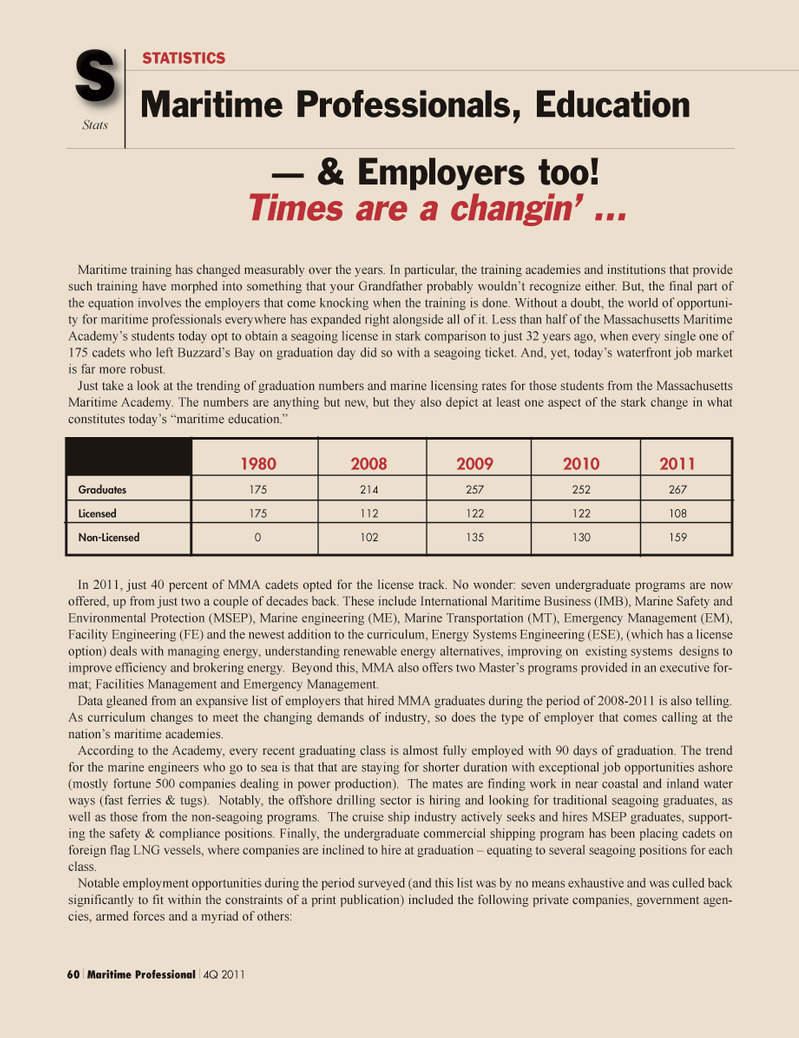
Page 60: of Maritime Logistics Professional Magazine (Q1 2012)
Training & Maritime Security
Read this page in Pdf, Flash or Html5 edition of Q1 2012 Maritime Logistics Professional Magazine
60 Maritime Professional 4Q 2011Maritime training has changed measurably over the years. In particular, the training academies and institutions that provide such training have morphed into something that your Grandfather probably wouldn?t recognize either. But, the final part of the equation involves the employers that come knocking when the training is done. Without a doubt, the world of opportuni- ty for maritime professionals everywhere has expanded right alongside all of it. Less than half of the Massachusetts Maritime Academy?s students today opt to obtain a seagoing license in stark comparison to just 32 years ago, when every single one of 175 cadets who left Buzzard?s Bay on graduation day did so with a seagoing ticket. And, yet, today?s waterfront job market is far more robust. Just take a look at the trending of graduation numbers and marine licensing rates for those students from the Massachusetts Maritime Academy. The numbers are anything but new, but they also depict at least one aspect of the stark change in what constitutes today?s ?maritime education.? In 2011, just 40 percent of MMA cadets opted for the license track. No wonder: seven undergraduate programs are now offered, up from just two a couple of decades back. These include International Maritime Business (IMB), Marine Safety and Environmental Protection (MSEP), Marine engineering (ME), Marine Transportation (MT), Emergency Management (EM), Facility Engineering (FE) and the newest addition to the curriculum, Energy Systems Engineering (ESE), (which has a license option) deals with managing energy, understanding renewable energy alternatives, improving on existing systems designs to improve efficiency and brokering energy. Beyond this, MMA also offers two Master?s programs provided in an executive for- mat; Facilities Management and Emergency Management. Data gleaned from an expansive list of employers that hired MMA graduates during the period of 2008-2011 is also telling. As curriculum changes to meet the changing demands of industry, so does the type of employer that comes calling at the nation?s maritime academies. According to the Academy, every recent graduating class is almost fully employed with 90 days of graduation. The trend for the marine engineers who go to sea is that that are staying for shorter duration with exceptional job opportunities ashore (mostly fortune 500 companies dealing in power production). The mates are finding work in near coastal and inland water ways (fast ferries & tugs). Notably, the offshore drilling sector is hiring and looking for traditional seagoing graduates, as well as those from the non-seagoing programs. The cruise ship industry actively seeks and hires MSEP graduates, support- ing the safety & compliance positions. Finally, the undergraduate commercial shipping program has been placing cadets on foreign flag LNG vessels, where companies are inclined to hire at graduation ? equating to several seagoing positions for each class.Notable employment opportunities during the period surveyed (and this list was by no means exhaustive and was culled back significantly to fit within the constraints of a print publication) included the following private companies, government agen- cies, armed forces and a myriad of others: SStatsMaritime Professionals, Education ? & Employers too! Times are a changin ...STATISTICS 19802008200920102011 Graduates175214257252267 Licensed175112122122108 Non-Licensed0102135130159

 59
59

 61
61
